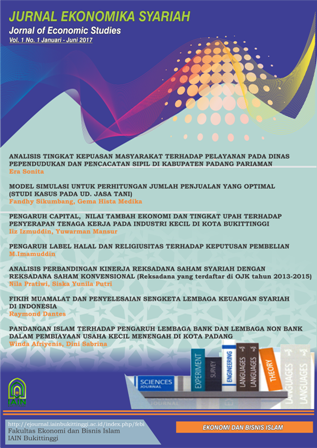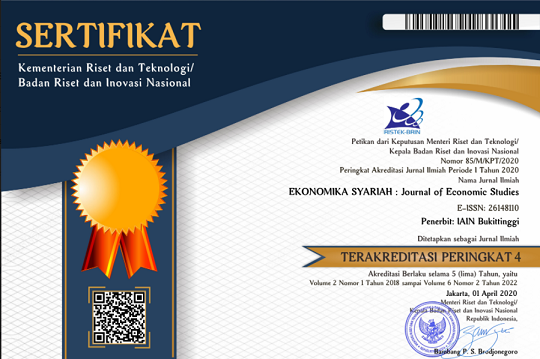PENGARUH CAPITAL, NILAI TAMBAH EKONOMI DAN TINGKAT UPAH TERHADAP PENYERAPAN TENAGA KERJA PADA INDUSTRI KECIL DI KOTA BUKITTINGGI
DOI:
https://doi.org/10.30983/es.v1i1.447Abstract
The background of this research is to know the factors that influence the absorption of labor in small industry sector in Bukittinggi. The results of this research is expected to improve the scientific discourse of the economics development, especially about the absorption of labor in the small industrial sector. The hypothesis testing in this research is moderating regression by using t test, F test and coefficient of determination (R2). The population of this research is all small industry sector in Bukittinggi. The sampling technique in this research is using Slovin method, then, the sample obtained is 58 small industry in Bukittinggi. Based on the results of the research, it is known that the capital does not affect the absorption of manpower in the small industrial sector in Bukittinggi. Thus, H1 is denied the truth, it means the increase of capital made by the company to add modern machines or equipment capable of generating economic added value ) is bigger than human power. This is in line with the basic concept of relationship between factors of production (substitution or Complement) it means the addition of production factors (capital) will reduce the other factors of production (Labor). Economic value added positively and significantly influence the absorption of labor in small industry sector in Bukittinggi, so that H2 accepted. It means that high demand of labor force demanded by businessman (Demand of labor) is influenced by the high amount of goods produced by labor. This is related to the effect of output or the effect of the scale of production. It means the normal factor of production (output) will increase the use of other factors of production (labor). The wage rate has a negative and significant effect on the absorption of labor in the small industrial sector in Bukittinggi, so that H3 is accepted.it means that the higher the wage rate, the less employers demand for labor. This is in accordance with the theory of wages, namely the ability to pay from the company by calculating the profit Penelitian ini dilatarbelakangi untuk mengetahui faktor-faktor yang mempengaruhi penyerapan tenaga kerja pada sektor Industri Kecil di Kota Bukittinggi. Hasil penelitian ini diharapkan dapat meningkatkan wacana keilmuan bidang Ilmu Ekonomi Pembangunan khususnya mengenai penyerapan tenaga kerja pada sektor indusri kecil. Pengujian hipotesis dalam penelitian ini menggunakan alat analisis regresi moderating dengan uji t, uji F dan koefisien determinasi (R2). Populasi dari penelitian ini adalah seluruh industri kecil di Kota Bukittinggi. Teknik pengambilan sampel pada penelitian ini menggunakan metode Slovin, sehingga diperoleh 58 industri kecil di Kota Bukittinggi sebagai sampel penelitian. Berdasarkan hasil penelitian, diketahui bahwa Capital (modal) tidak berpengaruh terhadap penyerapan tenaga kerja pada sektor industri kecil di Kota Bukittinggi, sehingga H1 ditolak kebenarannya, artinya peningkatan modal yang dilakukan oleh perusahaan untuk menambahkan mesin atau peralatan modern yang mampu menghasilkan nilai tambah ekonomi (produksi) lebih besar dibandingkan tenaga manusia. Hal ini sejalan dengan konsep dasar hubungan antar faktor produksi (substitusi atau Komplemen) yaitu penambahan faktor produksi (modal) akan mengurangi penggunaan faktor produksi yang lain (Tenaga kerja). Nilai tambah ekonomi berpengaruh positif dan signifikan terhadap penyerapan tenaga kerja pada sektor industri kecil di Kota Bukittinggi, sehingga H2 diterima kebenarannya, artinya tinggi rendahnya jumlah tenaga kerja yang diminta oleh pengusaha (Demand of labor) dipengaruhi oleh tinggi rendahnya jumlah barang yang diproduksi oleh tenaga kerja tersebut. Hal ini berkaitan dengan efek output atau efek skala produksi, yakni pada faktor produksi normal bila terjadi penambahan skala produksi (output) akan meningkatkan penggunaan faktor produksi yang lain (tenaga kerja) Tingkat upah berpengaruh negatif dan signifikan terhadap penyerapan tenaga kerja pada sektor industri kecil di Kota Bukittinggi ,sehingga H3 diterima kebenarannya, artinya semakin tinggi tingkat upah, semakin kecil permintaan pengusaha akan tenaga kerja. Hal ini sesuai dengan teori upah, yaitu kemampuan membayar dari perusahaan dengan memperhitungkan kemampulabaan.References
Badan Pusat Statistik. 2010. Bukittinggi Dalam Angka 2016, Bukittinggi: BPS
Cuyvers Reth Soeng, Ludo. 2011, "The effects of Belgian outward directinvestment in European high-wage and low-wage countries onemployment in Belgium", International Journal of Manpower, Vol. 32 Iss3 pp. 300 – 312.
Fadliilah, Diah Nur dan Atmanti, Hastarini Dwi. 2012. “Analisis PenyerapanTenaga Kerja Pada Industri Kecil (Studi Kasus di Sentra Industri KecilIkan Asin di Kota Tegal)â€, Diponogoro Journal of Economics Vol. lNo.1: hal 1-13.
Gumanti, Indra. 2012. Pengaruh Nilai Investasi, Nilai Upah, dan Nilai Produksi terhadap Penyerapan Tenaga Kerja pada Industri Mebel di Kecamatan Pedurungan Kota Semarang. Economics Development Analysis Journal 1 (2) (2012)
Ghozali, Imam. 2005. Analisis Multivariat dengan Program SPSS. Edisi ke-3.Badan Penerbit UNDIP. Semarang.
Gujarati, Damodar. 2003. Ekonometrika Dasar: Edisi Keenam. Jakarta: Erlangga
Hasibuan, Sayuti. 2009. Ekonomi Sumber Daya Manusia (Teori dan Kebijakan).
Jakarta: LP3ES.
Haryani, Sri. 2009. Hubungan Industrial di Indonesia. UPP AMP YPKN.
Kuncoro, Mudrajad. 2009. Usaha Kecil Di Indonesia: Profil, Masalah, dan
Strategi Pemberdayaan. Jurnal Usaha KecilI ndonesia. Tersedia di: http://sintak.unika.ac.id/staff/blog/uploaded/ 5811998215 / files /struktur_ekonomi_-umkm.pdf [diunduh: 4 Agustus 2017].
Muhammad Ikhsan,. 2013. Analisis Faktor-Faktor yang Mempengaruhi Penyerapan Tenaga Kerja pada Industri Kecil (Studi Kasus Pada Industri Kerupuk Sanjai, di Kecamatan Mandiangin Koto Selayan, Kota Bukittinggi). Jurnal Ilmiah. Universitas Andalas Padang.
Mahajan, Kanika. 2015,"Farm wages and public works", Indian Growth andDevelopment Review, Vol. 8 Iss 1 pp. 19 – 72
Marksberry Fazleena Badurdeen M.A. Phillip Maginnis, 2011,"An investigation
of Toyota's social-technical systems in production leveling", Journal of Manufacturing Technology Management, Vol. 22 Iss 5 pp. 604 -620.
Sulistiyo Arman. 2013. Analisis Faktor yang Mempengaruhi Penyerapan Tenaga Kerja Industri Kreatif di Kota Denpasar. Jurnal Ekonomi. Fakultas Ekonomi Universitas Udayana (Unud), Bali, Indonesia.
Singarimbun, Masri. 2005. Metode Penelitian Survei. Jakarta : LP3S
Sugiyono. 2011. Metode Penelitian Pendidikan. Bandung: Alfabeta.
Sumarsono, Sony. 2003. Ekonomi Manajemen SDM, ketenagakerjaan.Yogyakarta: Graha Ilmu.
Vicente Roca-Puig Inmaculada Beltrán-MartÃn Mercedes Segarra Cipres,2011),"Combined effect of human capital, temporary employment andorganizational size on firm performance",Personnel Review, Vol. 41 Iss 1pp. 4 – 22.
Wei Li Zhichao Zhang, 2012, "International capital flows, the domesticemployment and wages", China Finance Review International, Vol. 2 Iss 3pp. 286-31
Downloads
Submitted
Published
Issue
Section
License
Authors who publish with this journal agree to the following terms:
- Authors retain copyright and grant the journal right of first publication with the work simultaneously licensed under a Creative Commons Attribution-ShareAlike 4.0 International License that allows others to share the work with an acknowledgment of the work's authorship and initial publication in this journal.
- Authors are able to enter into separate, additional contractual arrangements for the non-exclusive distribution of the journal's published version of the work (e.g., post it to an institutional repository or publish it in a book), with an acknowledgment of its initial publication in this journal.
- Authors are permitted and encouraged to post their work online (e.g., in institutional repositories or on their website) prior to and during the submission process, as it can lead to productive exchanges, as well as earlier and greater citation of published work (See The Effect of Open Access).













